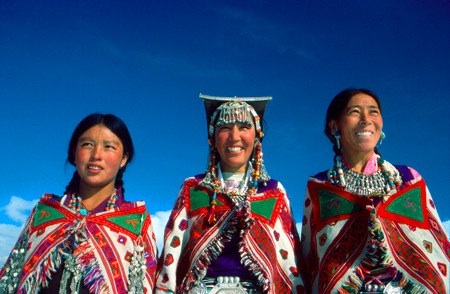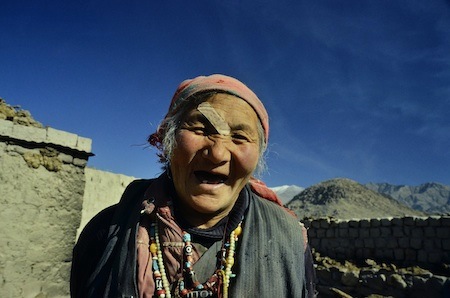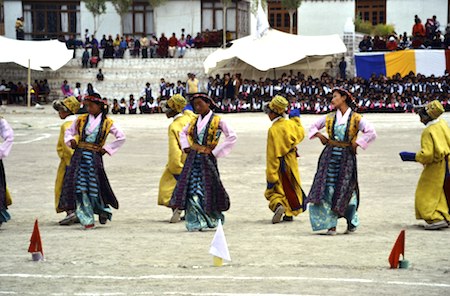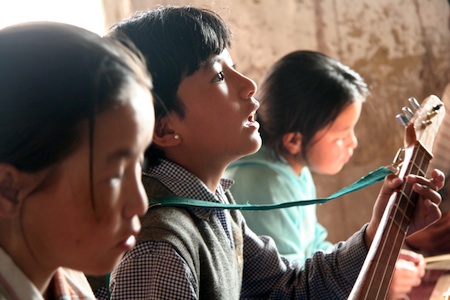Songs From Exile

Songs from the rural world, song for work and conviviality, songs of exil searching for identity and open to other cultures : the music life of the Tibetan refugees in Ladakh precisely reflects their itinerary between Tibet and India, between their peasant roots and a multicultural modernity.
A festive life
Jampa Jangdol spent the first thirty years of her life as a cultivator in the Tashigang area of Western Tibet, before the arrival of the Chinese. “Life was quite happy : we had to work hard but the result was there. We grew barley, radishes, potatoes, carrots, pees… Little money was circulating. Whatever we needed, we produced it by ourselves or, in the case of meat and wool, we bartered for it with nomads. Music was involved in every aspect of our life, enlivening our work in the fields as well as our gatherings. It was a very festive life, and Tashigang was full of music and dance.”
“There wasn’t a single day without music,” remembers musician Sherap Dorjee. “Every evening, when the sun set, the people would gather in one of the massive stone houses of the village to perform thalu, line-singing : the adults sat in hierarchical order (lama, aristocrat, rich farmer, poor farmer…) in two lines, one for men, one for women.”
Performed a cappella with a grave slowness, thalu are precious songs about the most morally valuable aspects of life. “We always began with the serious and spiritual matters," recalls Sherap. “Only later, we would shift to lighter entertainment : the unmarried boys and girls would walk out to dance gorshey under the stars, while inside the house, the adults would tell stories to the children before they went to bed.”
Gorshey, the round dance, was the most popular entertainment among young people in rural communities of Western Tibet. “Gorshey was performed without instruments,” explains Sherap, “ the dancers would sing while stomping on the ground. But in my region To Tso Yultuk, we developed the unique practice of accompanying gorshey with the kovo lute."
Main instrument in Western Tibetan music, the kovo is a three-double-stringed lute used to play full and fluid rhythmic lines. “ There were many instruments, “continues Sherap, “and my father, the village’s musician, played them all : violin, oboe, drums, flute, jaw harp…"

Exile
The exile in Ladakh changed all that. Not at once though, and not everywhere.
The first years, when the refugees camped in the grazing land of Chang Thang, while others were cultivating the high valley of Chumur, song and dance kept enlivening social life, as it used to in Tibet. “In autumn, after harvest,” recalls Tenzin Nyendak, “the nomads used to come with their animals to fertilize our fields, and they sang and danced everyday. That’s how I learned many songs.” “In Chumur,” explain the singers of Shang Shung Da Yang, “we used to sing all the time, almost every evening. And when visitors came, we took them for a picnic – every pretext was good !”
In the Leh Valley where most of the refugees live nowadays, things are different. “I now live in Choglamsar,” continues Tenzin Nyendak, “and it is not a good environment for singing, it’s not like up there, in Chang Thang…"
Choglamsar is the Ladakhi village around which were built the main Tibetan refugee camps. Though not completely urban, this environment is by no means rural : agriculture and animal husbandry are impossible ; most of the inhabitants survive by working as laborers, whether on public construction sites or for private entrepreneurs. Small-scale community life has not survived in this vast settlement gathering thousands of refugees. The evening gatherings slowly disappeared, and with them line-singing and circular dances, a world of subtle poetry and shared joy which illuminated peasant life.

Institutions
Nevertheless, the exile community as a whole maintains itself firmly by resting on an institution born in India : the Tibetan Government in Exile, established by the Dalai Lama after he left Tibet. This effective state apparatus organizes the refugees’ life, its most visible institution being the school system.
Music is one of the many fields taken care of by this administration. TIPA (Tibetan Institute of Performing Arts) trains music teachers who are sent to the many Tibetan schools all over India and Nepal. Instruments, songs and dances are thus propagated with the purpose of preserving traditional Tibetan culture during the time of exile.
Even though this centralized approach leaves aside entire sections of Tibetan music culture, it allows for the spreading of new forms : orchestral music, stage choreography, patriotic songs, etc… Peasant music, participative and based on local repertoire, have made way for pan-Tibetan music, sponsored by institutions and tailored for public shows.
Besides, Tibetan refugees enjoy listening to the modern songs privately recorded by exiled artists such as the immensely popular Tsering Gyurmey.
And in the case of the refugees in Ladakh, they are also fond of Ladakhi and Hindi pop songs, which they can hear all day long on local radio and public transportation. And they don’t hesitate combining musical cultures, mirroring their existence, straddling between worlds…

This journey, from the rural songs of Western Tibet to the music invented in exile, is the story told in the album Songs from exile, which we recorded with the Tibetan refugees of Ladakh of all generations.